17 Mistakes Everyone Makes With Potato Salad
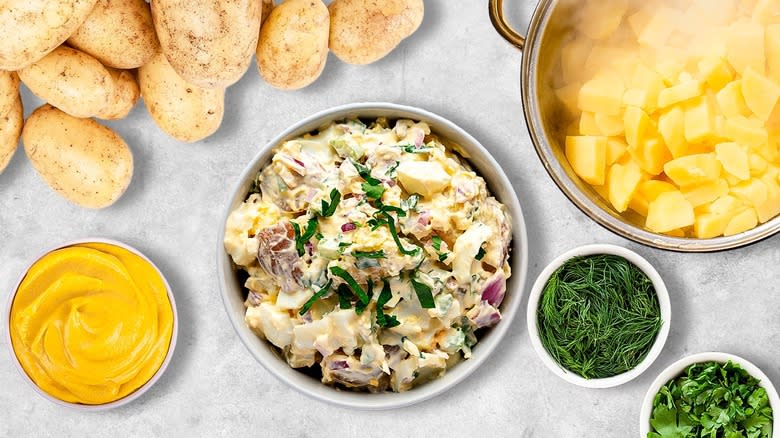
No summer barbecue is complete without hot dogs, watermelon, and (of course) potato salad. This warm-weather staple is super versatile and can be made with a variety of different ingredients. Some folks opt for a classic Southern potato salad made with soft, creamy potatoes, copious amounts of mayonnaise, crunchy celery, and hard-boiled eggs; others may prefer something lighter with seasonal herbs and grassy olive oil. Realistically, once your potatoes are soft? You have the creative license to make this iconic summer side dish your own.
Not to say you won't encounter some major hurdles along the way. After all, if you overcook your potatoes, neglect to add the correct balance of ingredients, or fail to store them correctly? You risk being the talk of the potluck -- and not in a good way. Having experimented a lot with the side dish over the years, we're well aware of some common pitfalls when making potato salad. Here are 17 mistakes everyone makes with potato salad -- and our best tips for overcoming whatever issues you may encounter when preparing the dish.
Read more: Hacks That Will Make Boiling Your Eggs So Much Easier
Using The Wrong Type Of Potato

With so many different varieties of potatoes out there, how are you supposed to select the right one for potato salad? Well, for most people, a waxy spud is the go-to choice. The firm texture and smooth skin of these varieties prevent them from getting too soggy and breaking down when you boil them -- making them the best type to use for a classic potato salad. Red bliss, fingerling, and new potatoes -- which refers to the name (not the age of) the potato -- are all varieties that would work well here.
We recommend opting for a starchy variety for creamier potato salad, like a russet or a Yukon Gold. These varieties are often used for baking and frying because of their impressive size and high starch content, but they can be utilized for a Southern-style potato salad, too. The texture of these potatoes will ensure they fall apart the second you start mixing them, so you'll get a consistency more akin to mashed potatoes.
Always Using Fresh Potatoes
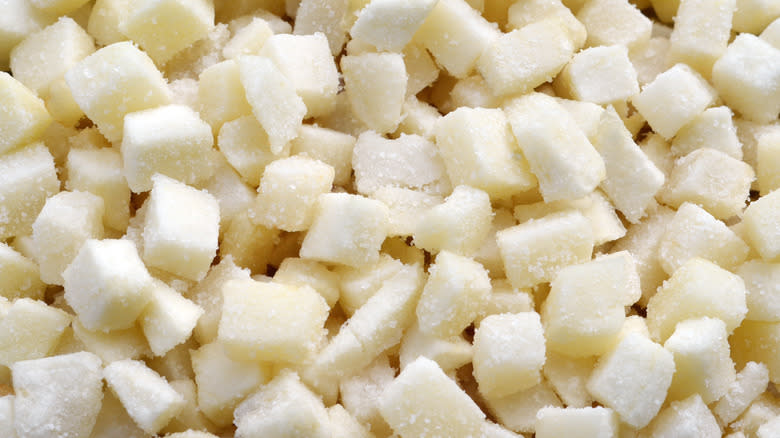
Let's be honest: Making potato salad always takes longer than expected. Between boiling, cubing, and dressing your potatoes, you may be looking at nearly two whole hours of work. Instead, turn to the freezer for a quicker, crunchier twist on classic potato salad. Start with a bag of cubed hash browns; you'll want to go with a diced variety rather than hash brown patties or thin shreds. You can still use the shreds if you like since they're also made of pre-cooked potatoes, but the mouthfeel will differ significantly from the cubes.
Bring your potatoes up to temperature by blanching the spuds in hot water before dressing them with your chosen toppings. The key to getting the perfect texture on these potatoes is not overcooking them. Since the frozen potatoes are pre-cooked before arriving in the grocery store's freezer section, no more than three to four minutes in a pot of boiling water should suffice.
Only Sticking To Boiling Your Potatoes

You don't have to boil your potatoes to make a potato salad. One of our favorite preparation methods involves roasting spuds for your potato salad instead. The heat will help the potatoes get super crispy and brown, providing a colorful textural contrast to a standard plain bowl of potato salad.
Be sure to stick with waxy potatoes when using this recipe to make potato salad. These varieties tend to stay intact as they roast and remain crunchy, as well, rather than disintegrating like a baked potato. You can stick with your standard dressing and ingredients for a roasted potato salad or go with something a bit more unconventional. Your roasted spuds -- which should be smothered in olive oil and seasoning before popping them into the oven -- would play well with bacon, mayonnaise, and fresh herbs.
Haphazardly Cubing Your Potatoes

Cubing any vegetable requires keen attention to detail. Taking the time to ensure your potato pieces are cubed correctly not only makes for an Instagram-worthy bowl of potato salad but also ensures your potato pieces cook evenly. There isn't a standard for how large or how small you should chop your pieces for potato salad -- all that matters is each piece is equal.
We recommend aiming for ½-inch pieces, though, since it's the standard for many easy potato salad recipes. Another key to making a quality potato salad is to avoid cooking your potatoes for too long. If you cut the potatoes into small pieces, you should expect to keep your potatoes in the boiling water for roughly 15 minutes or so. You can stick them with a fork to ensure they're soft enough.
Neglecting The Steaming Technique

Boiling your potatoes is an antiquated method of making potato salad. Instead of waterlogging your spuds with water, you should consider steaming them instead. This potato-cooking method provides a surefire way to prevent watery potato salad because it prevents the veggies from soaking up additional water while ensuring they come out fork-tender every time.
Aside from these textural benefits, steamed spuds also retain more of their natural flavor since there's no water to dilute them. If you don't have a steamer basket handy, you can opt for a colander instead. Add your peeled, cubed potatoes to the heat-proof colander and suspend it a few inches above your boiling water. Then cover your taters with a lid to keep the steam from escaping while they cook.
Sticking Exclusively To Potatoes

While the name potato salad implies the involvement of spuds, there's a world of other vegetables (and even fruits) that you can add to your summertime side dish to make it more exciting. If you're opting for a low-carb dinner, you can even swap out potatoes entirely for a cauliflower "potato" salad. The cruciferous veggie soaks up the mayonnaise and fresh dill very well and acts as a crunchy yet blank canvas for all of your salad flavors.
If you're a stickler for using actual potatoes, you could make an Asian-inspired Korean potato salad by boiling your carrots with the potatoes before tossing in chopped red onions, apple cider vinegar, grated egg yolk, and crunchy cucumbers. You can also turn up the heat on this variation by adding a drizzle of gochujang to the top before serving, as well.
Not Adding Enough Salt To The Water
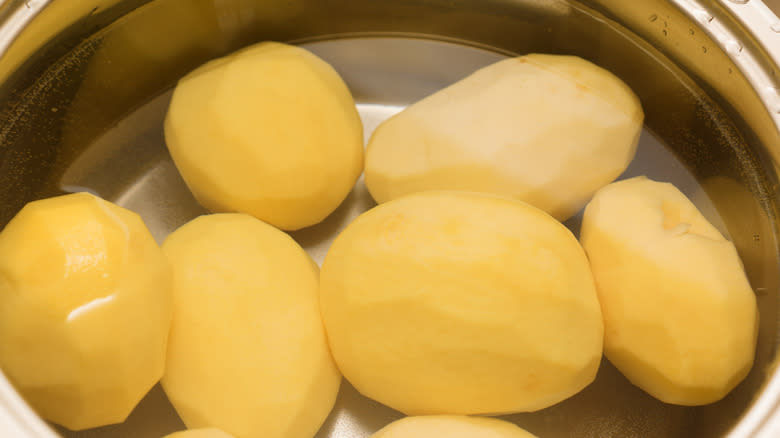
You might have always been told to salt your pasta water, but does the same also apply to potato water? The short answer is yes. In fact, you should always salt the water when making potato salad because the step will lend a more profound flavor to the spongy taters as they soften in water.
Now, you'll want to liberally season the potato water to the tune of an entire cup of salt (yes: you read that correctly). If this seems like an unfathomable amount of salt to recklessly toss into the pot, remember that most of the water will be drained off in the end. Plus, the fatty dressing you add to your salad will likely offset any residual saltiness.
Neglecting To Season Your Potatoes With Salt After Boiling

You shouldn't just season your potatoes as they're boiling, though. Celebrity chef Jamie Oliver always starts his potato salad by tossing the spuds with salt after the water's been drained and the root vegetables are still warm. There's a fairly limited window for imparting flavor to your potatoes once they finish cooking, after all, as their cell walls close off soon after the tubers start to cool.
"When you flavor things when they're cold," as Oliver explained on YouTube, "it just sits on the outside. Because it's hot, whatever you put in now will go into the actual veggies." Besides adding a dash of salt, Oliver also adds some high-quality extra-virgin olive oil, lemon zest, lemon juice, salt, and pepper before he selects his dressing.
Pouring Your Dressing On Hot Potatoes

Deciding when to dress your potatoes is certainly a tricky balance. With that in mind, the best time to dress potato salad with any cream-based mayonnaise dressings is after the potatoes have cooled down to the touch. If you immediately slather a creamy dressing right on top of your hot spuds, we can all but guarantee it will slosh off the sides and make for an oily mess.
However, this timing rule doesn't apply to every single type of potato salad dressing. If you're using a non-cream dressing -- such as a vinaigrette or mustard, for instance -- you can add it to the potatoes immediately after they've finished cooking. This will ensure the spuds soak up the flavors of the oil and the dressing without the additional worry of cream separating from the heat.
Discarding Your Potato Water
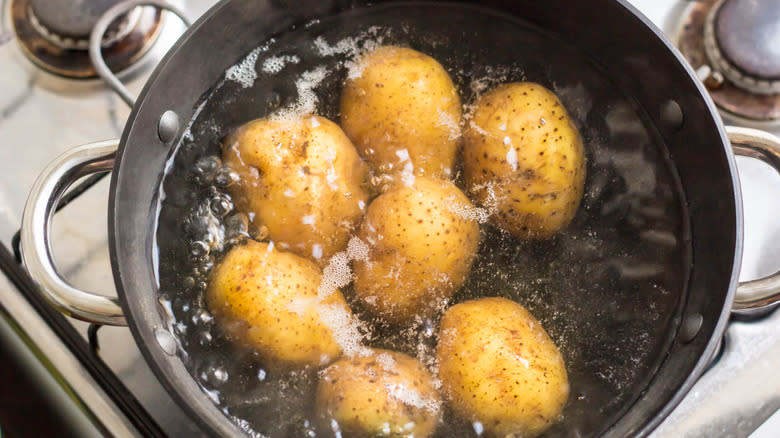
Potato water may not have the same utility as pasta water, but it's still an ingredient you'll want to keep on hand rather than dumping it down the drain right away. Since this water is filled with starch molecules from the potatoes, a little bit can help thicken the dressing the same way pasta water can be used to thicken pasta sauce -- which is why Ina Garten saves her cooking water to help thicken her potato salad.
The Barefoot Contessa credits Julia Child for this culinary tip and recommends keeping at least 1 cup of potato water on hand to incorporate with everything from vinaigrette-based potato salads to mayonnaise-centric concoctions. Garten also adds a splash to her dressing before coating the potatoes. While you might assume this tip would make the dressing exceptionally wet, the mixture is apt to thicken up in the fridge before serving.
Only Using Yellow Mustard
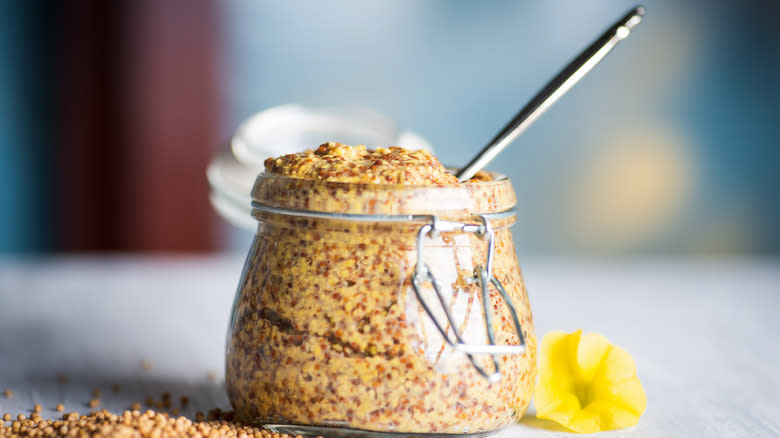
We went through many years of our culinary lives without venturing past yellow mustard. Sure: A bottle of French's has a very subdued flavor that's great for drizzling onto a ballpark hot dog, but it doesn't quite make the cut for potato salad. Instead, using whole-grain mustard is the secret to richer, tangy potato salad -- and is guaranteed to give your standard recipe a revamp.
When you utilize this chunky mustard, you'll likely notice your salad's texture and flavor take a step up. Each bite is filled with punchy mustard seeds that have moderate, earthy wine notes. For those unfamiliar with the taste of whole-grain mustard, we recommend sticking to no more than 2 tablespoons, in addition to tasting it along the way. So grab a bottle of whole-grain mustard next time you're at the store and watch your whole potato salad game get upgraded.
Not Trying A Different Dressing

We have a feeling that when people talk trash about potato salad, it's not because they hate potatoes. Rather, their gripe is with mayonnaise. Now, your supermarket deli selection may say otherwise, but there are many additional dressings you can adorn your potato salad with that don't involve mayonnaise.
Ranch dressing, for example, is an easy way to switch up potato salad that infuses bright dilly notes into your dish. You can toss in buttermilk, Greek yogurt, and your favorite herbs as well to give your potato salad a more complex flavor than mayo ever could.You could also go light with a French potato salad. This recipe only contains champagne vinegar, olive oil, and Dijon mustard -- giving your spuds a bright, summery feel that's perfect for serving alongside a cheese platter and grilled chicken.
Neglecting Acidic Ingredients

Although there may be some amount of lemon juice or vinegar already included in your dressing, you'll still want to hit your potato salad with a little bit of extra tang. Of course, there are plenty of ingredients available to help incorporate some much-needed additional acid in your recipe. But our personal favorite is pickle juice, which is the potato salad ingredient you didn't know you needed (and one that will change your favorite recipe forever).
The brine found in a jar of pickles contains more than just acid, though, as there's likely some sugar and salt in the liquid, as well -- a combo that gives your potato salad some well-rounded flavor. Depending on the brine you select, you might find it also contains savory herbs and aromatics like dill and garlic. Either way, try pouring a small splash of juice into your next dressing and give it a taste after it's had the chance to mellow out in your fridge.
Adding Too Much Acid
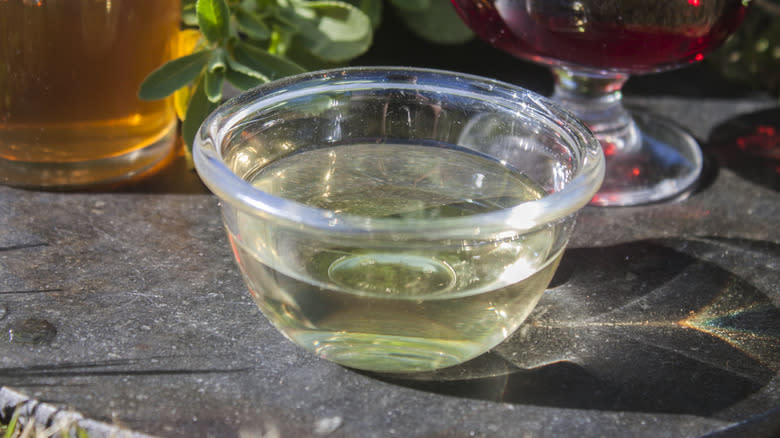
Potato salad is all about managing the precarious balance of flavors and ingredients in your salad. A little too much vinegar or salt can tip the scales in a bad direction, so you'll want to constantly taste and tweak your recipe as you go. But if you happen to lose your grip on the vinegar bottle or lose track of how many tablespoons of lemon juice you added to the bowl, fear not -- there are some ways you can balance a salad that's too acidic.
For one thing, excess vinegar tends to drip off potato salad the longer the dish is left in the refrigerator, so you can pop your bowl in the fridge for a few hours and then drain off any moisture at the bottom. You can also take an expedited approach to remediating your salad by using extra ingredients. To fix a potato salad that has too much acid, try salvaging it with a bit of lemon zest. The lemon zest's acid will counteract the liquid and restore harmony to your salad. You can also add a teaspoon of sugar a little at a time, though taste it often to prevent oversweetening.
Not Using Enough Herbs

Potato salad is designed to be a rich side dish (it's often smothered in mayonnaise, after all). But you can bring some brightness to a somewhat dense salad by incorporating some fresh herbs. One of our favorite summer staples is dill potato salad, which packs 4 tablespoons of fresh dill to touch your tastebuds with grassy and citrusy notes.
Dill is the perfect herb to add to your salad because it doesn't detract from the other flavorful ingredients, like garlic and onion, and complements proteins like grilled chicken or burgers fresh off the grill. Another herb that you can add to your potato salad is parsley. It has a slightly metallic flavor, but adding it as a garnish for color or chopping up a few sprigs to add will ultimately serve your salad well.
Leaving It On The Countertop Too Long

Potato salad is a staple for summer cookouts, but you'll need to take some extra steps to ensure your side dish doesn't sicken any partygoers. The downside of using mayo in your potato salad is that you'll have to keep it cold to prevent it from harboring foodborne illnesses. Clostridium perfringens -- a bacterium responsible for a large number of food poisoning cases each year, according to the CDC -- loves to live in warm environments, after all, including that bowl of potato salad you left on the picnic table in the hot summer sun.
Even if you use copious amounts of vinegar in your salad, the overall acidity isn't sufficient to keep this pathogen at bay. With this in mind, you can either keep your potato salad chilled during a party or opt for a mayo-free salad. If the temperatures at your gathering are above 90 degrees Fahrenheit, your potato salad should only be left out of the fridge or cooler for a maximum of one hour. At temperatures lower than that, you'll have about two hours to enjoy your potato salad before needing to toss it in the trash.
Attempting To Freeze Your Potato Salad

Thinking about frozen potato salad may make you queasy -- and rightfully so. After all, if you're like us, this phrase conjures up a bowl of creamy mush with some discernable flecks of freezer-burnt herbs. Yuck!
Now, to be sure, you shouldn't consider freezing your potato salad if you're using a mayonnaise or cream-based dressing because it's guaranteed to taste drastically different (and likely worse) than when you put it in. This is because these types of dressings tend to separate into oil and water when frozen. If your dressing contains sour cream, you'll also risk your salad coming out grainy.
Oil-based dressings, though, are a safer bet to freeze. Add your salad to a freezer bag, remove as much air as possible, and keep it for a maximum of three months. However, a major caveat with this method is that the freezer will change the color of your potatoes from creamy white to dull gray -- which can't be reversed, unfortunately. In other words, since it's relatively easy to make a new batch at home -- or, worst case scenario, pick up a container at the deli -- we recommend you avoid freezing potato salad altogether.
Read the original article on Tasting Table.

